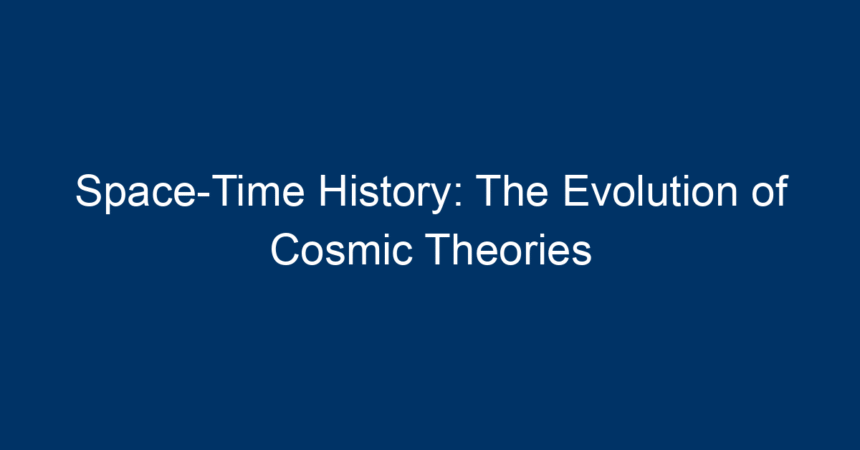Introduction
The universe, in its vastness and mystery, has always intrigued humanity. At the heart of our understanding lies the concept of space-time history—a framework that intertwines the dimensions of time and space. It is within this intricate web that cosmic theories have evolved, shaping our understanding of the cosmos and our place within it. From the ancient philosophers to modern astrophysicists, this journey through space-time history reveals how our perceptions of the universe have transitioned from mystical interpretations to rigorous scientific analyses.
In this article, we will explore the key developments in cosmic theories, examine the influential figures who shaped our understanding of space and time, and look ahead at emerging ideas that may redefine our grasp of the universe.
The Ancient Foundations of Cosmic Thought
Philosophical Beginnings
Long before the advent of modern science, ancient civilizations pondered the nature of the universe. Philosophers such as Plato and Aristotle laid the groundwork for cosmic theories. Plato proposed a model of a harmonious universe governed by perfect geometric forms, while Aristotle posited a geocentric view of the cosmos, placing Earth at the center.
Ptolemaic System
The Ptolemaic system, developed by Claudius Ptolemy in the 2nd century CE, further solidified the geocentric model. This highly elaborate framework, with its complex system of epicycles, dominated astronomical thought for over a millennium. However, this perspective would soon be challenged by revolutionary ideas.
The Copernican Revolution
A New Perspective
The Copernican Revolution marked a pivotal moment in space-time history. Nicolaus Copernicus introduced the heliocentric model, proposing that the Sun, rather than the Earth, was at the center of the universe. This radical shift not only altered our understanding of cosmic bodies but also introduced a new way to think about space and time.
Impact on Science and Philosophy
The implications of the heliocentric model were profound. It prompted astronomical observations and mathematical innovations and laid the groundwork for future thinkers like Johannes Kepler and Galileo Galilei. Kepler’s laws of planetary motion introduced ellipses as the paths of planets, while Galileo utilized telescopic observations that challenged long-held beliefs and provided empirical evidence for Copernicus’s theories.
Newtonian Mechanics: Unifying Space and Time
Isaac Newton’s Contributions
In the late 17th century, Sir Isaac Newton further advanced the understanding of space-time history through his laws of motion and universal gravitation. Newton’s insights provided a framework for understanding how celestial bodies interact within the cosmos.
The Concept of Absolute Space and Time
Newton’s notion of absolute space and time proposed that they exist independently of the objects within them. According to this view, time flows uniformly, and space serves as a fixed stage upon which the events of the universe unfold. This paradigm would dominate scientific thinking for centuries, until it faced challenges in the 20th century.
The Birth of Relativity
Einstein’s Revolutionary Ideas
The early 20th century ushered in a new era of understanding with the introduction of Albert Einstein’s theory of relativity. His groundbreaking works—special relativity (1905) and general relativity (1915)—transformed the concepts of space and time, merging them into a unified continuum known as space-time.
Special Relativity
Einstein’s special relativity challenged the notion of absolute time, introducing the idea that time is relative and dependent on the observer’s velocity. The famous equation (E=mc^2) illustrated the interchangeability of mass and energy, fundamentally altering our understanding of cosmic phenomena.
General Relativity
General relativity further revolutionized our understanding of gravity. Rather than viewing it as a force acting at a distance, Einstein described gravity as the warping of space-time caused by mass. This geometric interpretation led to predictions about black holes, gravitational waves, and the expansion of the universe, which have since been validated through experimental observations.
Quantum Mechanics: The Uncertainty Principle
The Quantum Revolution
As the 20th century progressed, the field of quantum mechanics emerged, introducing concepts that contrasted sharply with classical physics. Pioneers such as Max Planck, Niels Bohr, and Werner Heisenberg provided new insights into the behavior of subatomic particles, challenging deterministic views of the universe.
The Role of Time in Quantum Mechanics
In quantum mechanics, time becomes a more complex entity. Heisenberg’s uncertainty principle indicates that certain properties of particles cannot be concurrently measured with precision, leading to philosophical implications about determinism and the nature of reality. This intertwining of effects profoundly influenced theories about the fundamental structure of the universe and our understanding of space-time itself.
The Cosmological Principle and the Expanding Universe
The Big Bang Theory
In the mid-20th century, the Big Bang theory emerged as the leading explanation for the origin of the universe. It posits that the universe began from a singular point, rapidly expanding and cooling. This theory is fundamental to contemporary cosmology and fosters discussions about the ultimate fate of the universe.
Hubble’s Law and Cosmic Expansion
Edwin Hubble’s observations provided empirical support for the expanding universe, establishing his law that galaxies are moving away from each other. This dynamic picture of the cosmos has led to further investigations into the nature of dark energy and the overarching structure of space-time.
Dark Matter and Dark Energy: Grand Mysteries of Space-Time History
The Quest for Understanding
In recent decades, astrophysicists have discovered that the observable universe accounts for only a small fraction of its total mass-energy content. Dark matter and dark energy, invisible and mysterious components, make up approximately 95% of the universe. These enigmas challenge our existing models of space-time and prompt researchers to rethink fundamental questions in physics.
The Future of Cosmic Theories
The exploration of these dark components has ushered in a renewed understanding of the universe’s dynamics. Future studies aim to uncover the nature of dark matter and energy, potentially leading to a grand unification of physical theories. As we continue to push the boundaries of knowledge, our grasp of space-time history will inevitably evolve.
Conclusion: Embracing the Journey through Space-Time History
The exploration of space-time history reveals a remarkable evolution of thought, from ancient philosophical notions to modern scientific theories. Each leap in understanding has brought us closer to deciphering the cosmos and our role within it.
As we stand on the brink of new discoveries—whether through advancements in technology, shifts in theoretical paradigms, or exploration of cosmic phenomena—it’s essential to engage with these evolving concepts. For anyone curious about the universe, delving into books, participating in discussions, or following the latest research can provide insights that enrich our understanding of space-time.
Embrace the journey, for the evolution of cosmic theories will undoubtedly continue to unfold, transforming our view of the universe for generations to come.




